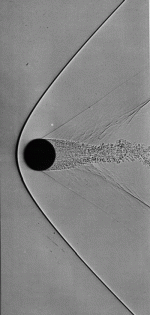P
pacecil
Guest
Vibe, You've brought up something very interesting! The Vortex gun presents a really good illustration of what is happening here. It made me go and do a little "testing" rather than rely on science - and my gut feeling.
What I found using an air compressor and a nozzle was that I could in truth start air motion that would have effect several seconds later on a object 30' away. There was no way I could get it to have an effect 60 seconds later but I could get up to 8 seconds. That effect amounts to air moving about 1 mph at the 4 second point, so there could be effect on bullet flight if you get the second shot in within this time limit.
If I increased air pressure to simulate a gun firing then the effect would reach the object quicker and probably would travel farther. I suspect with the driving force you get out of a gun barrel, or a vortex cannon, you might have a blast of air that reaches the target by the time you fire the second shot.
I tried bouncing the air movement off walls, floor, and ceiling such as inside a tunnel and could never see maintenance of any significant air velocity. In fact I could never hold any velocity of air in the vicinity of where the second bullet might be traveling a few seconds after the first.
I tried swirling air around in a circular restriction to simulate turbulence and found I could maintain the circular motion for only about 1 or 2 seconds. I was using a path about a foot in diameter but I'm pretty sure if the swirls were less, say 2-3 inches then the mass of air would be less and the motion wouldn't last as long.
All things considered I still think you could only see air motion caused by the first bullet as having effect on the second one only if you fired at an interval of just a few seconds.
What I found using an air compressor and a nozzle was that I could in truth start air motion that would have effect several seconds later on a object 30' away. There was no way I could get it to have an effect 60 seconds later but I could get up to 8 seconds. That effect amounts to air moving about 1 mph at the 4 second point, so there could be effect on bullet flight if you get the second shot in within this time limit.
If I increased air pressure to simulate a gun firing then the effect would reach the object quicker and probably would travel farther. I suspect with the driving force you get out of a gun barrel, or a vortex cannon, you might have a blast of air that reaches the target by the time you fire the second shot.
I tried bouncing the air movement off walls, floor, and ceiling such as inside a tunnel and could never see maintenance of any significant air velocity. In fact I could never hold any velocity of air in the vicinity of where the second bullet might be traveling a few seconds after the first.
I tried swirling air around in a circular restriction to simulate turbulence and found I could maintain the circular motion for only about 1 or 2 seconds. I was using a path about a foot in diameter but I'm pretty sure if the swirls were less, say 2-3 inches then the mass of air would be less and the motion wouldn't last as long.
All things considered I still think you could only see air motion caused by the first bullet as having effect on the second one only if you fired at an interval of just a few seconds.


